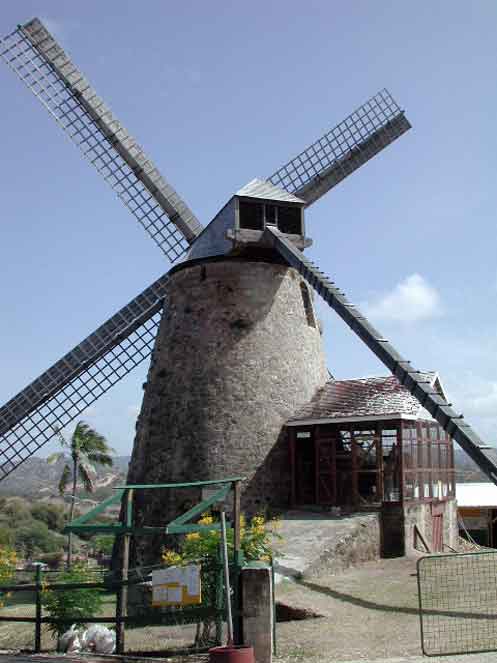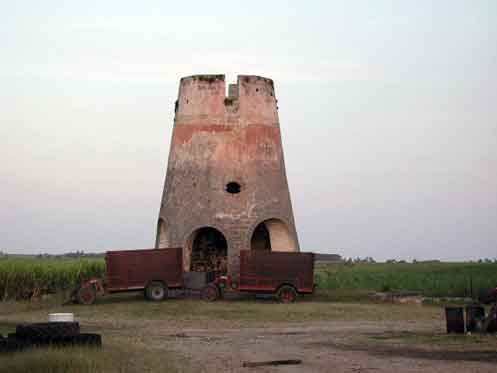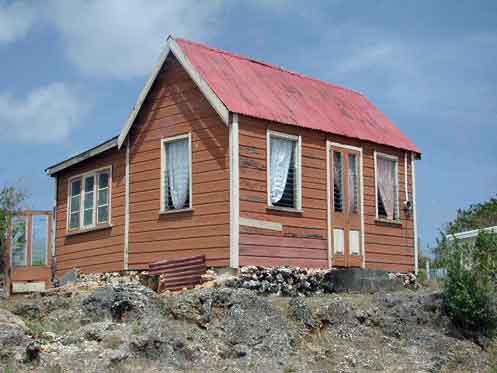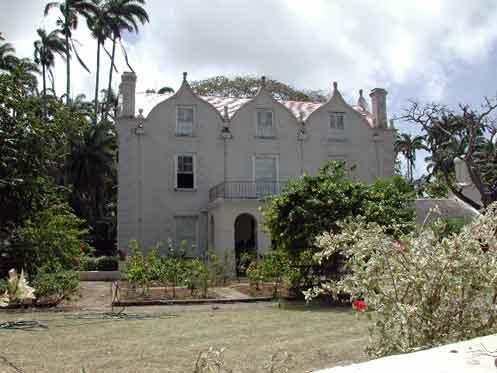2003: Bridgetown, Barbados
DATE: 2003 October 12-16
ORGANIZER: Frank Ainsley, Tom Loftfield & Kathleen Goddard Loftfield
THEME: “The Carolina-Barbados Connection”
FIELD TRIP ITINERARY:
(1) Cultural Landscapes
of Barbados
(2) Walking Tour of
Bridgetown
(3) Chattel Houses,
Plantations, Signal Stations &
Sugar Factories

Barbados sunset
Abstracts of Papers Pioneer America Society,
Bridgetown, Barbados, October 14-15, 2003
Tuesday, October 14th, 2003, 8:00 pm
Keynote Address: Open Issues in the Study of the Historic Influences of Caribbean Architecture on That of North America
Jay D. Edwards, Louisiana State University
We know less about the historic influences of the Caribbean on the architectonic cultures of the United States and Canada than we should. Theories of influences are so numerous that it would require a catalog to cover them, but convincing proofs are mostly lacking. Yet, it is precisely Caribbeanization that has made North American domestic vernacular architecture distinctive and un-European. Three different levels of influence can be charted. In huristic spirit, I will briefly discuss eight of the most compelling open questions in the long history of North American vernacular traditions and their Caribbean origins:
- The role of early West African feitorias, barracoons and comptoirs on the creole architecture of the Caribbean and North America.
- The origins of the American Creole cultural landscape in 16th - 17th century Pernambuco, and its subsequent diffusion into the Caribbean and North America.
- The role of the European military on the grid plan urban layout and on architectural form in the West Indies and North America.
- The 17th century creolization of the 16th century Italo-Spanish renaissance colonial villa (Casa del Almirante, Engombe, Palavé) in Hispanola, Cuba, Colombia and Mexico.
- The origins of the Piazza/Veranda/Gallery. Full-length "walks or porches" on Caribbean houses are reported in the British Caribbean as early as 1774 (Antigua; Froude), and even as early as 1689 in Jamaica (Sloane)-long before their appearance into North America.
- The origins of the shotgun house (ti' kay) in Saint Domingue, and its later geographical diffusion and popularity in Cuba (la salchicha) and North America.
- The Anglo raised creole house and its introduction into the Carolina Tidewater.
- The origins of the French colonial vernacular form classes in Saint Domingue/Haiti, and their transportation into colonial Louisiana:
The smaller hip-roofed creole cottage (to rural Louisiana)
The raised creole plantation house (to urban and rural Louisiana)
The urban creole cottage (to New Orleans).

Morgan Lewis Sugar Mill
Session I Tuesday, Oct. 14, 8:00-9:40 AM
Plantation Connections: North America and Barbados
Chair: Floyd Mansberger, Fever River Research
8:00-8:25 am The Sugar Connection: Holland, Barbados, Shelter Island
Gaynell Stone and Ofer Cohen, Suffolk County (NY) Archaeological Association
The University of Massachusetts-Boston ongoing archaeological field school at Sylvester Manor, one of five 17th century manors on Long Island, is re-writing the published histories of Long Island, of which it is a part. The material culture unearthed by the annual field schools indicates a multicultural lifeway at the Manor and evidence of its role as a provisioning plantation for the Sylvester's two sugar plantations on Barbados. This unique story is being filmed as a feature length documentary to bring this new perspective to a larger regional and national audience on PBS. Previews from three years of filming will provide a visual setting for Dr. Mrozowski's review of the archaeological and documentary evidence from the site.
8:25-8:50 am Provisioning St. Georges's Valley on Barbados: Archaeology at Sylvester Manor, Shelter Island, NY
Steve Mrozowski, University of Massachusetts-Boston
This paper presents a summary of the excavations at Sylvester Manor, a seventeenth-century provisioning plantation of Shelter Island, New York. During the second half of the seventeenth-century this large plantation provided many of the provisions for to large sugar plantations on Barbados. Constant and Carmichael Plantations were located in the St. Georges' valley of Barbados. They were owned in part by two brothers, Constant and Nathaniel Sylvester. Nathaniel ran Sylvester Manor, a plantation that encompassed the entire 8,000 acres of Shelter Island when it was established in 1652. Archaeological excavations have provided a unique perspective on the interaction between Barbados and the plantation in New York, and the kinds of material culture, foodstuffs and livestock that was being shipped to Barbados. The results of the research are also chronicled in a documentary film "The Sugar Connection" that will be screened as part of the presentation.
8:50-9:15 am A French-Caribbean Plantation in Central Maryland
Paula S. Reed, Paula S. Reed and Associates, Hagerstown, MD
Maryland's only French-Caribbean plantation lies near Frederick. Victoire Vincendiere and her family, wealthy coffee planters from western St. Domingue, fled the island's 1790s slave insurrection. In America they created a plantation in the wheat-producing region of central Maryland. The plantation's principal buildings remain intact, distinctive among mid-Maryland's typical German-influenced farmsteads. Victoire arrived in Baltimore in October 1793, just days past her 17th birthday. She, her mother, brother and sisters were living in Frederick by December. By summer 1794, they developed l'Hermitage, a plantation near Frederick that became a haven for homeless St. Domingue refugees. Victoire emerged as head of the family and the plantation with its 750 acres and 90 slaves. Her father, Etienne survived the revolt, but settled in Charleston, SC, arriving there in February, 1793. He lived there in poverty until his death in 1802, never joining the rest of his family in Maryland. Documentary research and examination of the buildings and archaeological evidence illuminates the story.

Drax Hall
Session II Tuesday, Oct. 14, 10:00-11:40 AM
The British Caribbean and Connections to the Wider Atlantic World
Chair: Artimus Keiffer, Wittenberg University
10:25-10:50 am The Question of Colonial Regionalism in the Greater British Caribbean
Louis P. Nelson, University of Virginia "It is not necessary that traditions and ceremonies be in all places one, or utterly alike, for at all times they have been diverse, and may be changed according to the diversity of countries, times, and men's manners." By including these words in the 1571 foundational document "The 39 Articles" the authors understood that the Anglican Church would take a multitude of forms as it was realized in a multitude of local circumstances. In the seventeenth and eighteenth centuries, the established Anglican Church would be one of the most important institutions of British colonial authority. Yet, the extent to which British culture generated local and regional variations in her colonies has not been fully explored. This paper depends on fieldwork undertaken in South Carolina, Jamaica and the Leeward Islands of Nevis, St. Kitts and Antigua to examine seventeenth and eighteenth-century Anglican Churches as a lens into the balance between emergent local traditions and the construction of a common British Caribbean identity.
10:50-11:15 am Barbados, Charleston, and Devon: Architectural Influences in the Wider Atlantic World
Roger H. Leech, University of Southampton
The author's recent survey and reassessment of two later seventeenth Barbados houses, Alleynedale Hall and St Nicholas Abbey, together with recent surveys and excavation of seventeenth and early eighteenth century-houses on the island of Nevis, will provide a starting point for the proposition that the material culture of the Eastern Caribbean and Carolina in this period cannot be studied in isolation from that of the wider Atlantic world. The development of gentry and urban housing in later seventeenth and early eighteenth century south-west England will be shown to be especially relevant in any re-evaluation of the origins of the Charleston house. The paper will focus on both real and superficial similarities between Barbados and Charleston houses and those of south-west England, in particular those of the city of Bristol and the seaport towns of Devon.
11:15-11:40 am Colonial policy and Hybrid Housing in the British West Indies, 1929-1950s
Richard Harris, McMaster University
Slowly after 1929, the British Colonial Office began to encourage colonial governments to develop housing policies for indigenous populations. This compelled governments to consider what form housing should take, and eventually to consider hybrid possibilities that combined indigenous with imported designs, materials, and building methods. In the British West Indies, island governments at first tried to build public housing in the style of British cottages and flats, but these proved expensive and often unpopular. In Puerto Rico after 1938, the U.S. began to fund large public housing projects, including some that experimented with aided self-help. Using a limited range of designs and mainly modern materials (concrete) these were eventually touted worldwide, but especially to Britain's West Indian colonies. There, because finances were weaker, public housing and self-help schemes incorporated more indigenous materials and methods of construction, both in cities and in rural schemes for sugar workers.
1:15-2:00 pm Lunch Address From Barbados to the Cape Fear: Archaeological Findings
Tom Loftfield, University of the West Indies at Cave Hill

Small Chattel House
Session III Tuesday, Oct. 14, 2:00-3:40 PM
Material Culture of the Caribbean
Chair: Keith A. Sculle, Illinois Historic Preservation Agency
2:00-2:25 pm Mask Making and Mask Use in Puerto Rico
Allen G. Noble and Mario Cora-Cruz, University of Akron
Masks are cultural features found throughout the Caribbean region. Intimately linked to Roman Catholic celebrations, such as Carnival, they also may have connections to both Indian and African sources. This paper, in addition to discussing these aspects, also focuses upon the masks makers, their training, the materials, and techniques they utilize, as well as various geographical patterns assorted with mask making. A possible connection with Louisiana Cajun and Peruvian-Bolivian masks and ceremonies is suggested.
2:25-2:50 pm The Plaza-Parque Complex in Costa Rica
Marshall S. McLennan, Eastern Michigan University
This paper expands the literature concerning the Spanish colonial plaza complex in the New World by identifying and analyzing the unique development history and townscape of the plaza complex in Costa Rica. One distinctive feature of the Costa Rican plaza is that it has traditionally been used as the community's soccer field. Another distinctive feature is the low density of buildings surrounding the plaza as compared with other Latin American countries. The varying development and location of plazas in Costa Rican towns provides the basis for elaborating a typology of plaza types. In recent decades Costa Rican plazas have been evolving into landscaped squares called parques and a plaza townscape more akin to those of neighboring countries. This evolutionary process attests to a revaluation of the square's community role from utilitarian to formal symbolic space.
2:50-3:15 pm Housing an Immigrant Work Force: Eastern Aruba, 1924-1960
Marshall E. Bowen, Mary Washington College
Before Aruba became a prime tourist destination, its economy was based on refining oil shipped in from Venezuela, particularly at Standard Oil's Lago facilty near the eastern end of the island. In 1949 the number of Lago employees peaked at about 8,300, more than the total population of the island thirty years earlier, before refining began. Some employees were native Arubans, but the vast majority were brought in from abroad. This paper, concentrating on events from the 1920s through 1960, describes the migration of workers to Aruba, examines the procedures used to provide housing for them, and provides a hint of the changes that took place as Lago's prominence in island life began to diminish.
3:15-3:40 pm The Changing Landscape of Eastern Aruba
Dawn S. Bowen, Mary Washington College
In the 1950s the cultural landscape of eastern Aruba was closely tied to the operation of an enormous oil refinery and the provision of housing for its employees. Right next to the refinery was the rough and tumble town of San Nicolas, home to many of the refinery's laborers, while a short distance to the southeast lay Seroe Colorado, a gated community that housed the mostly American upper-level work force. Since that time, the refinery has fallen upon hard times, bringing profound change to all of Aruba, and particularly to the eastern part of the island. This paper describes the rise and fall of Seroe Colorado, and analyzes the none-too-successful attempts made by San Nicolas to reinvent itself as a tourist destination.

St. Nicholas Abbey, Barbados
Session IV Tuesday, Oct. 14, 4:00-5:40 PM
Folk Housing: Caribbean Influences
Chair: Tracey Sculle, Illinois Historic Preservation Agency
4:00-4:25 pm Vernacular Hospitality in the Carolinas: The Tidewater Cottage and the Preacher Room
M. Ruth Little, Longleaf Historic Resources
The Creole Cottage [coastal cottage, Tidewater cottage, raised cottage] of the West Indies, Deep South, and elsewhere has been extensively documented as the distinctive dwelling built by Spanish and French creoles from the early 18th century. Its role as one of the earliest refined Carolina types is less well known. The 1 ½ story cottage has an engaged gallery (piazza, veranda) along one or more elevations, and small (half) rooms partitioned into the galleries. My paper will build on substantial scholarship, particularly of two contemporary scholars, Jay Edwards and Philippa Oszuscik. The house type has been studied little outside of the Deep South.
My paper will study the social usage of one room in the house type--the small bedroom partitioned into the gallery --which often had no entry into the main house. This was apparently a special category of bedroom that played a social role in the antebellum South. I will focus on the significance of the porch room, sometimes called "preacher room" in the Sandhills section of North Carolina in the 19th century, as illustrated in the travel journal of Frederick Law Olmsted, A Journey through the Seaboard Slave State. Olmsted chronicled a trip that he made in the early 1850s along the seaboard South. His detailed descriptions of his lodgings in various private homes is the only known contemporary account that may shed light on how the preacher room actually functioned in the era prior to the appearance of widespread commercial lodging.
4:25-4:50 pm Two Houses with Caribbean Connections with French,
Spanish and Anglo-American Influences
Philippe Oszuscik, University of South Alabama
Two houses that bear no apparent similarities at initial sight externally are the Dorothy Walton cottage, 1800, of Pensacola, Florida, and the Major Nicholas Jarrot house, c. 1800-07, of Cahokia, Illinois. The Walton cottage has an obvious French and Spanish Creole heritage due to its integral front and rear galleries and general massing and vernacular detailing; but the Jarrot house appears to be a traditional Georgian planned, two-story structure externally, with Federal Period detailing. This paper will explore how Anglo-American citizens came into a French or Spanish territory and adapted their Anglo architectural heritage with Caribbean traits to fit in with the neighbors. For example, close to the Jarrot house is the old 1737 Cahokia Courthouse of French Creole folk design and is next door to the old French Church. The Walton cottage was in an urban neighborhood of Spanish/French and British Creole cottages and remains mostly so today with even African-Creole housing in the proximity. Thus, both houses were built during a period that was still dominated by Creole house forms or influences from the Caribbean hearth. The heads of family of both houses were prominent leaders of the Federal Period on the state and federal levels and lived to see their housing become a part of the U. S. territory. They wanted to fit into the existing environment at the same time of expressing the latest fashion of the East Coast. When one evaluates the plans of these structures, one sees the similarity in the amalgamations that resulted except one is a single story and the other a two-story version of the plan. Both houses have plans that are rare to find in the field yet their designer/builders arrived at a similar, logical amalgamation while being unaware of each other as they were separated by nearly 800 miles. In fact, the differences in traditions that one easily perceives are due to a different geography and climate for each house. The fact that they both moved into an area that experienced influences from both the French and the Spanish creates the provocative comparison that exists.
One should expect the Walton cottage to be a Creole cottage, but one that is a mixture of French, Spanish, and Anglo-American heritage, it can be classified as a Gulf Coast American Creole cottage to reflect the more complicated amalgamation. The fascinating thing about the Jarrot house is that it is removed many hundreds of miles farther from the Caribbean hearth and is more "American," yet it nevertheless retained a plan unusual for a Midwest location and is best explained that it came by way of the southern hearth rather than the current East Coast Federal source.
4:50-5:15 pm Looking for History's Huts: An Analysis of Extant Slave Housing in the South
Barbara B. Mooney, University of Iowa
As African Americans struggle to reclaim their critical position in the fabric of American history, the architectural component of the cultural landscape of slavery has offered problematic opportunities. As Adam Goodheart pointed out in his 2001 article in Preservation, the physical remains of slavery's built environment are often ignored, or, as the abhorrent development of slave quarter bed and breakfasts indicates, are exploited for crass commercial purposes.
This paper takes the measure of the current state of slave architecture by systematically analyzing the interpretative practices at approximately twenty quarter sites throughout the South. Fieldwork undertaken in the summer of 2003 addressed a number of inquiries including the current purpose of the site, availability and character of public information, relationship between free and bonded space, building data, and control of the interpretive discourse. Examining both well-known and less famous sites illuminates general trends and points to both laudable and lamentable examples.
Session V Wednesday, Oct. 15, 8:00-9:40 AM
Transportation and American Material Culture
Chair: Mark Reinberger, University of Georgia
8:00-8:25 am Railroad Bridges When They Had Slim Girders or Beams
Stephen Straight, Deland, Florida
I have collected old post cards of railroad bridges with slim girders or beams. According to the book "American Building" by Condit, this type of bridge had to change when engines and trains got heavier, usually around 1890. At first there were combination wrought iron and steel bridges, but then they became built of all steel. Braces were first added to the bridges, but when the loads became heavier, they had to be completely replaced. A wooden framework was needed upon which to build the bridge. With cantilever bridges, this wasn't needed. Often it's cheaper to rehabilitate a historic bridge than to tear it down and build a new one, but this rarely happens. Generally, people do not care as much about saving historic steel bridges as they do about preserving rustic old covered bridges.
8:25-8:50 am New York's Other Subway: The Hudson & Manhattan Railroad
Jeffrey L. Durbin, URS Corporation, Bethesda, MD
For much of its history, the Island of Manhattan was reachable only by water. Even though it soon assumed the status of America's largest city and railroads had reached the west bank of the Hudson River during the second quarter of the nineteenth century, the heart of New York City continued to be accessible either by ferry or bridges. Unfortunately, neither of these transportation systems provided an ideal solution to the problem of railroad trains gaining access to Manhattan. Coinciding with this difficulty was the problem of an overcrowded public transportation network on the island. Attempts to construct a subway were initially proposed during the fourth quarter of the nineteenth century, but completion of a viable system would wait until the following century.
Ultimately, the combination of streetcar lines, bridges, subways, and river ferries provided several alternate forms of transportation in and out of Manhattan. Often overlooked among these networks is the Hudson & Manhattan Railroad, which provided the island with its first subway connections to New Jersey. This paper will discuss the development of sub-aqueous tunnels linking Manhattan with the mainland and what impact this transportation system had-and continues to have-upon the New York landscape. The presentation will include historic photographs of the Hudson & Manhattan and present-day images of its modern counterpart, the Port Authority Trans Hudson (PATH) Train.
8:50-9:15 am Signs of the Times in America
John A. Jakle, University of Illinois at Urbana-Champaign
In a photo essay, I explore the role that signs play in American life, specifically as they serve to convey historical meaning in landscape. Organized around the concept of place, discussion considers how signs function to root places in time. Brief consideration is given to the following topics: the role of clocks, scheduling and the tempo of life, the referencing of life temporally, and the uses of historical markers in referencing the geographic past. My purpose is to excite scholarly interest in signage as material culture, but to do so in ways that inform larger issues of cultural landscape and social life. Places nest in landscape as centers of human concern. Signs in landscape, as they orient, direct and persuade, can have profound spatial implication. But places not only exist in space, but in time as well. Places open and close in daily, weekly, seasonal and annual cycles. And places change: often in stages, aging as from birth to death.
9:15-9:40 am The Impact of the Automobile on Post-World War II Housing Styles in Rural America
Thomas Rasmussen, Alfred University, New York
Rochester and Buffalo were centers of the industrial revolution in the Empire State, and village populations increased in rural New York as younger children abandoned the farm to work in the village. In the horse and buggy age, high transportation costs forced rural New Yorkers to buy their groceries, clothes and hardware on Main Street of the nearby village. Little housing was built during the Great Depression and during the war years. After World War II, a ranch home building boom reveals the profound influence of the automobile on community life. Garage becomes an extension of the home, the front door falls into the disuse, and the privacy-oriented backyard and patio replace the publicly oriented front porch. Photographs and census statistics reveal why manufactured housing dominates the rural housing landscape since 1970 - low cost, improved quality, changing family structure and new consumption patterns.
Session VI Wednesday, Oct. 15, 10:00-11:40 AM
Folk Architecture in the Eastern United States
Chair: Alice Morrison, North Troy, Vermont
10:00-10:25 am Some Observations Concerning Shotgun Houses in the Upper Ohio River Valley
David T. Stephens, Youngstown State University, and Alexander T. Bobersky, Heritage Entrepreneur, Warren, Ohio
The shotgun, a well-documented house type associated with the southern United States, has been shown to have Caribbean and African antecedents. Once imported to the Gulf Coast of the United States, diffusion of this house type was facilitated by waterways, railroads and mineral exploitation. This research reports on a reconnaissance along a 490-mile stretch of the Ohio River up stream from Portsmouth, Ohio. The intent of this foray was to discover the extent to which the shotgun house type had penetrated the Upper Ohio River Valley. Several hundred shotgun houses were identified in the Upper Ohio River Valley. In addition, we suggest that in some cases the shotgun concept was modified to meet local relief and climatic conditions. The frequency of occurrence, length of the structure, and amount of decorative detail of the houses increased downstream from Pittsburgh.
10:50-11:15 am Kohler, Wisconsin: A Contemporary Company Town by a Manufacturing Company
Michael W. R. Davis, Eastern Michigan University
Company towns curiously remain relatively unexplored subjects of scholarly research and exposition by geographers and historians. This slide-presentation paper on Kohler, Wisconsin, is the third by the author on the subject presented to the Pioneer America Society, all based on graduate studies in historic preservation at Eastern Michigan University and in industrial history at Wayne State University. Kohler, both company and town, are best known, unfortunately, for the labor strife that afflicted them in the 1930s and 1950s. But they also present an unusual architectural legacy and planning history. Both Kohler and the sugar plantations of the Caribbean share a common heritage of "company" housing adjacent to the mills of their particular commerce. Earlier PAS presentations by Davis included the 1915 DuPont company town at City Point, VA for munitions manufacture and the 1916 Inland Steel coal-mining town at Indianola, PA.
11:15-11:40 am Life on the Western New York Frontier: Letters of Victor Marie and Josephine DuPont, 1806-1809 Margaret Rasmussen, Alfred University, New York
French émigrés to western New York, Victor Marie and Josephine Du Pont, wrote these letters to friends and family from 1806 to 1809. Arriving in Angelica with introductory letters from Thomas Jefferson, The Du Ponts escaped from political turmoil in France to an agrarian life on the edge of the American frontier. Their letters, archived at the Hagley Museum in Wilmington, Del and never read, have now been translated. They offer a treasure of insights into life on the frontier. Did the relatively well off and cultivated families in early Angelica set themselves apart as a social elite? How did family members, forced to live in close quarters, deal with family tensions and disputes? How did settlers get rid of those pesky passenger pigeons? Why did the DuPonts abandon their experiment after three years and return to the east.
Download a PDF trip schedule from the Barbados meeting that includes the 2003 trip's intinerary as well as a brief history of Barbados. [View PDF]
